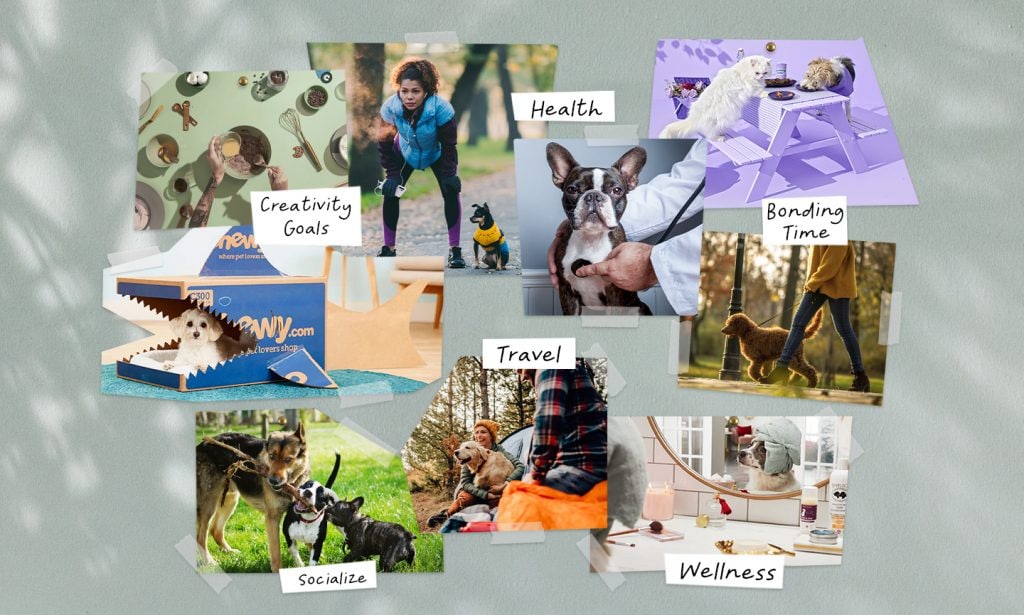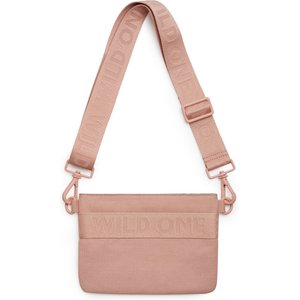At the start of the year, many people find themselves heads down and hard at work creating the perfect vision board. For some, that involves taking a pair of scissors and hacking away at magazines to create a poster-sized visual they’ll hang in their office. For others, that means creating a digital version on Canva and making it their desktop or phone background. Whether physical or digital, this vision board serves as a visual representation of the goals they want to manifest in their life—a life that, for many us, is totally centered around our pets.
So, why not include them in your vision board this year? Or, better yet: Create a pet vision board full of your shared goals, from prioritizing your health to going on more adventures together. We'll show you how to create one, offer up some pet vision board category and goal ideas, and explain how vision boards work.
Click on a button to jump to that section:
What Do I Put on a Pet Vision Board?
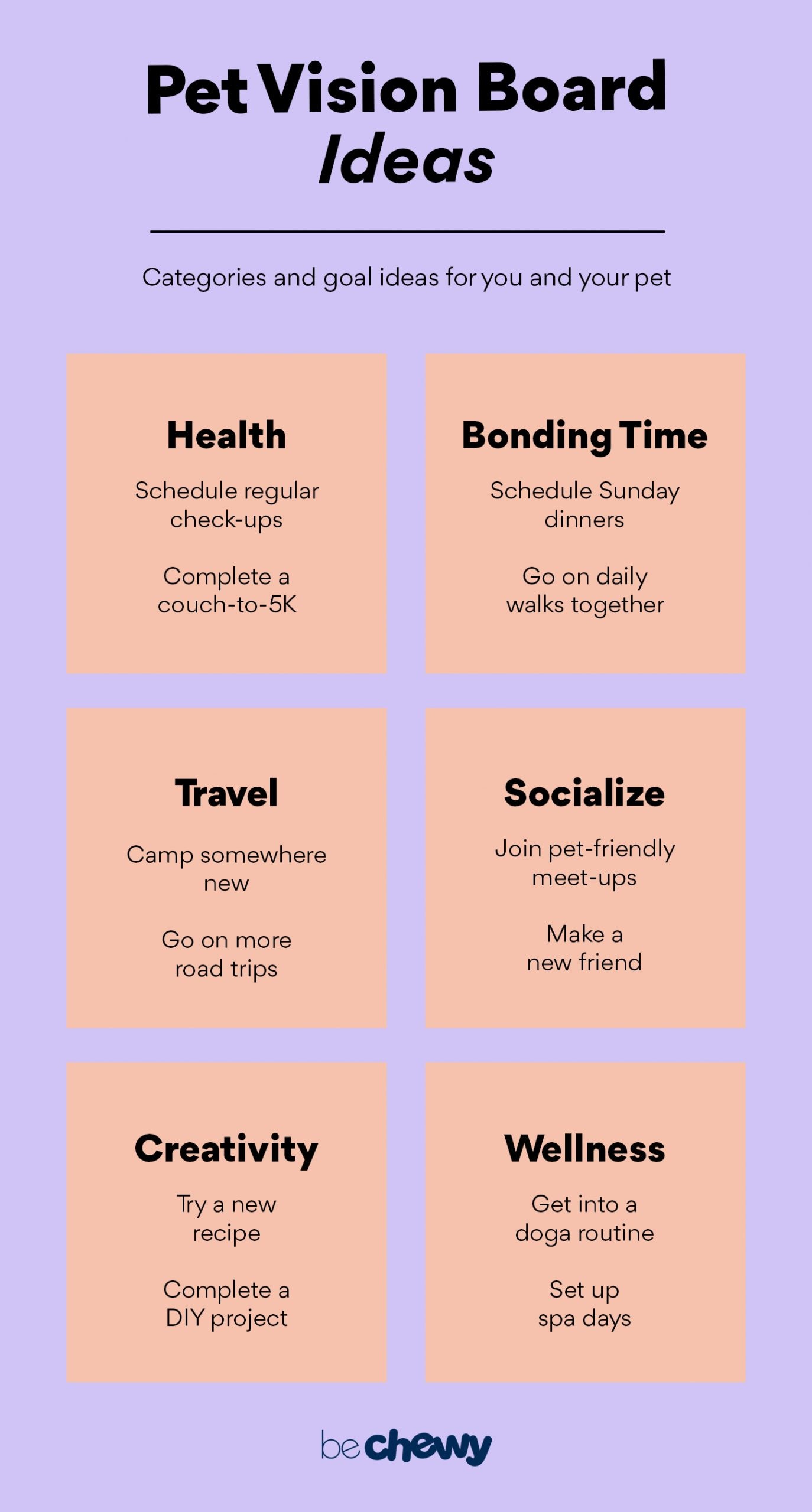
When deciding on goals for your vision board, do the following:
- Ask yourself, “What is it I want for myself and my pet?” For example, “[let’s say you] include agility equipment on your vision board because you’d love to compete in agility with your dog. Ask yourself why you want to compete in agility. Is it because everyone else is doing it or because you think you and your dog would really benefit from it?” asks Karoline Edmonds, founder of the Dog Mom Mentality blog and host of the "Dog Mom Mentality" podcast, where fellow pet parents discuss everything from mental health and well-being to the challenges of being new dog parents and more.
- Choose goals that are reasonable and fair. “Just because you can do something, doesn’t mean you should,” warns Edmonds. “Not every dog enjoys being in a busy environment or around other dogs, and just because they can act appropriately in the situation doesn’t mean they should intentionally be put in it.”
- Be honest with yourself. “It is important to make sure you’re creating a life you want to live, not what you think you should be doing or be persuaded by outside opinions,” Edmonds says.
Not sure where to start or what you want to manifest together? Here are some ideas for pet vision board categories and goals:
Health and Wellness
- Complete a couch-to-5k
- Get into a doga (dog yoga) routine
- Schedule regular check-ups
- Try guided meditation with your dog
Socialize
- Visit the dog park weekly
- Join pet-friendly meet-ups
- Attend agility competitions
Travel and Adventure
- Camp and experience nature
- Go on more road trips
- Visit local pet-friendly haunts
Beauty and Fashion
- Wear more matching outfits
- Level up your beauty routine
- Set up spa days
Creativity
- Try a new recipe (one for you and one for your pet)
- Complete a DIY project (like this Chewy box shark house)
Bonding Time
- Schedule regular Sunday dinners
- Go on daily walks together
- Make time for morning cuddles (physical touch boosts pet and parent happiness!)
How to Make a Vision Board
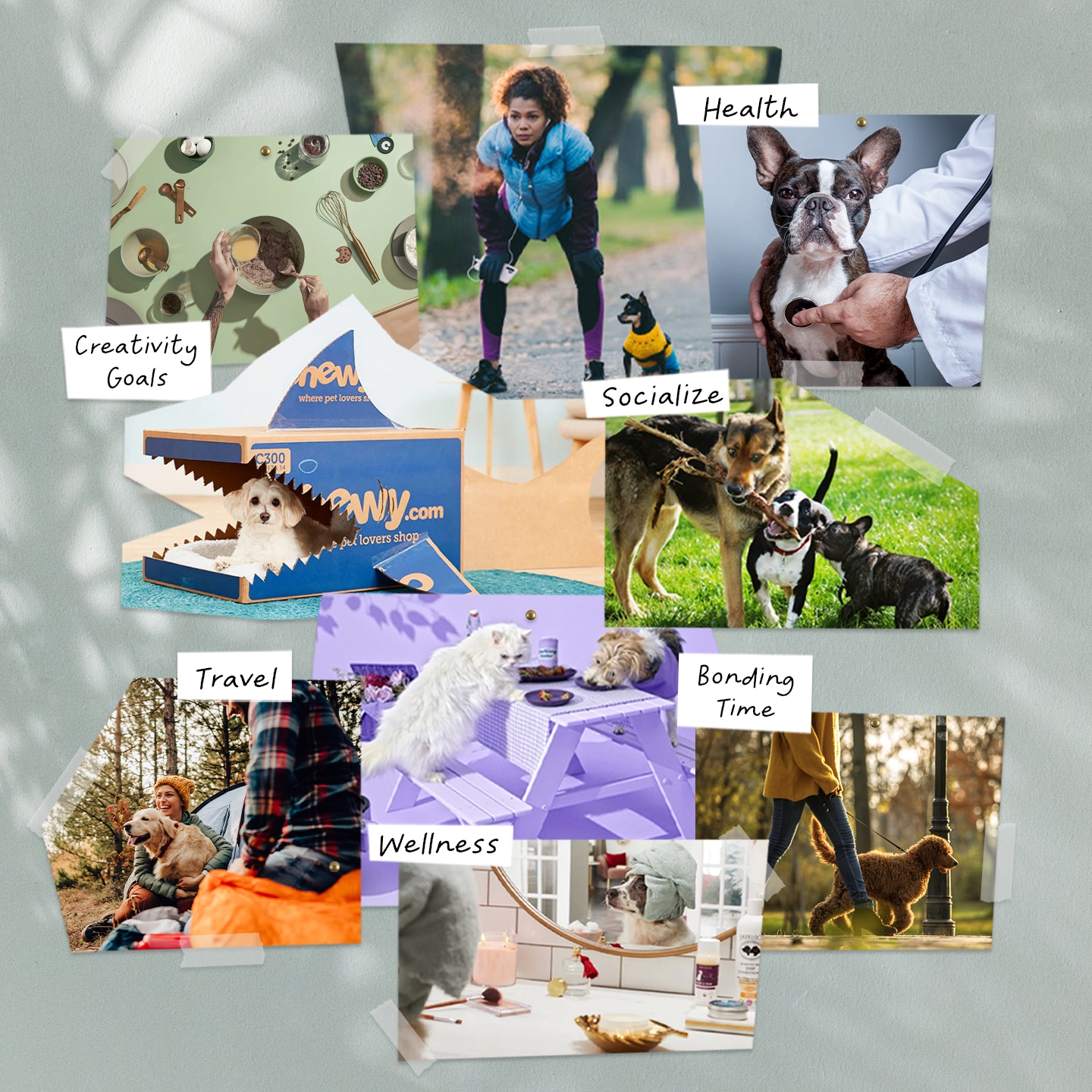
1Plan ahead.
It’s important to make intentional time for vision boarding.
- Choose a day and time to complete the activity and block the time off on your calendar, if needed.
- Identify where you’ll do your vision boarding (a relaxing environment is key!).
- Gather the materials ahead of time so when the day comes, it’s stress-free.
2Decide if you’ll make a physical or digital vision board.
There’s no wrong way to create a vision board.
“You could make your vision board on Landing Space or Pinterest initially… I love using [it] to find images,” says Edmonds. “Taking the time to physically cut out and place the images on a board can be so special, though.”
If you opt for virtual, another popular site is Canva, which has vision board templates.
3Get in the right headspace.
Before sitting down to start your vision boarding, opt for a practice that supports calm and relaxation. Think: meditation, breathwork, journaling, reading or going for a nature walk.
4Write down a few affirmations.
“You have to believe you are worthy of the things you are visualizing,” says Edmonds. “Getting over fears, emotions and limiting beliefs can take time. But as science shows, a daily affirmation practice can help rewire your brain and help you summon the courage and confidence you need to push beyond your comfort zones and biases.”
5Put on some jams.
Listening to music that’s about 60 beats per minute can change your brain waves and induce feelings of relaxation. Simply search “60 bpm” to find a playlist on a music app of your choice.
6Choose your categories and goals.
Above, we recommended categories, like travel and adventure, health and wellness and bonding time, and specific goals, like completing a couch-to-5k and scheduling regular check-ups; but you can choose whatever makes sense for you and your pet and the goals you want to achieve.
If you don’t know tangibly what you want to manifest in each category, think about how you want to feel. Write it down.
7Gather everything that inspires you.
Once you know what it is that you want to manifest or feel, start compiling…
- … images, words, phrases and letters that resonate with your newly identified goals. They can be from books and magazines (for a physical vision board) or the internet (for a virtual vision board). Edmonds’ past vision boards included words and phrases such as “free from anxiety,” “fulfilled” and “capable and confident” because they capture how she wanted to feel.
- … favorite pictures of you and your pet. Edmonds, for example, included a photo of her and her dog playing on the beach to represent more enjoyable times and adventures.
8Lay it all out.
You can lay things out before committing to their placement or simply start to glue, tack or virtually tape them down. Whatever feels good to you is the right thing to do.
9Put your finished vision board in a special place.
“Keep it somewhere you see every day,” Edmonds suggests. “Or, put it in a safe spot and set a reminder to get it out … to remind yourself what you are working towards.”
10Revisit and reflect.
View your visit board for a few minutes once or twice a day. Edmonds suggests doing a meditation or visualization practice with your vision board regularly to remind and imagine yourself achieving your goals. Create a plan, too, if you'd like!
How Vision Boards Work
“Visualizing works because you are putting yourself in the energy and feeling of having the things [that you desire],” explains Edmonds. “Just like thinking about a stressful situation can make your cortisol rise and cause your mood to shift, thinking about an ideal outcome can put your nervous system at ease and into a relaxed state.”
And when you’re more relaxed, you’re better able to filter out unwanted thoughts and information and, instead, attract the energy you put out.
Vision boards can also:
- Boost motivation: Knowing what you want and why you want it is half the battle. Vision boards can help you think through those things.
- Improve chances of success: Getting clear on what you want to manifest and then seeing it in your mind’s eye makes harnessing your focus and determination easier.
- Enhance productivity: Vision boards—when placed where you can regularly see them—can serve as constant reminders of your goals and help you stay on track toward achieving them. Keep your goals within reason and choose three to five, maximum.
Whether you decide to manifest for the long-term (three to five years in the future) or short-term (six months to one year), you get the opportunity to think about the life and future you want to create for you and your pet.
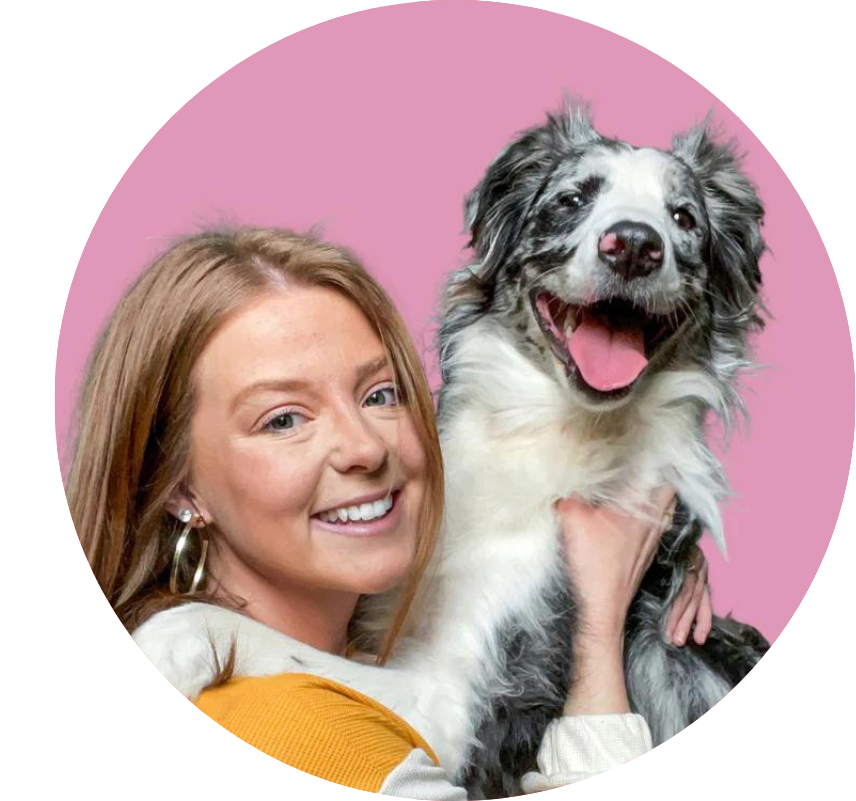
About the Expert
Dog mom to Australian Shepherd mix Layla, Karoline Edmonds is the founder and podcast host of Dog Mom Mentality. She is also the creator of "Growing & Heeling," a guided journal made specifically for dog owners. Broken down into four sections (intention setting, six months of goal setting, journal entries based on 10 common emotions that dog owners experience and a "wins" tracker), "the journal can be used to help you navigate tough situations, reorient your mindset and reminisce on great moments you’ve had with your dog!"
More ways to slay 2024:
Share:
